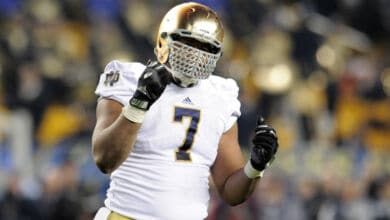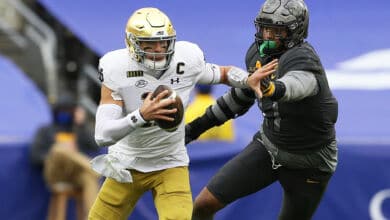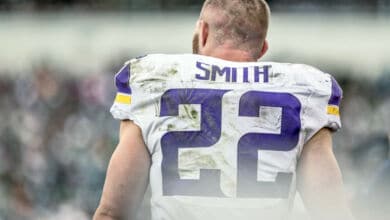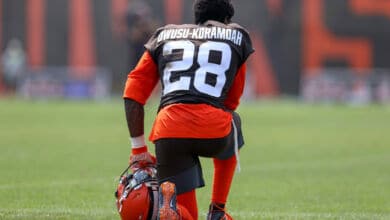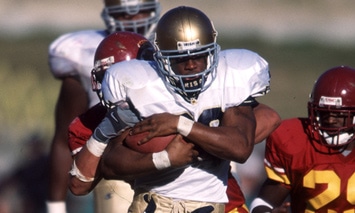
Dallas, TX (UHND) — Julius Jones finished his first NFL season with 819 yards and 7 touchdowns while playing only half of the season due to injuries. If you average that over a 16 game NFL season, Jones would have finished the year with 1,638 yards and 14 TDs — or just 59 yards short of the NFL rushing title — not bad for someone who wasn’t even the starter at the beginning of his senior season under the Dome.
It’s easy to imagine what could have been with Julius. Julius came to Notre Dame amid disappointment that Notre Dame missed out on some of their other top backs. Those disappointments soon faded away as video clips circulated the internet showcasing Jones’ top notch talent.
Jones made an impression on his first carry of his collegiate career and it wasn’t because it was an 80 yard touchdown or a tackle breaking highlight reel run. In fact, I don’t remember exactly how many yards the run went for. I do remember seeing Julius take that first hand off however and exploding off the line unlike any other running back on Notre Dame’s roster at the time.
Within little time Jones was seeing plenty of action and chalked up his first 100 yard game against Navy in his 8th career game. Jones’ performances as a freshman drew the attention of those in the football community leading to Jones’ name being listed in an Athlon Sports’ list projecting the all decade NFL team for the first decade of the new millennium.
The expectations were sky high for Jones, but his next two seasons would prove to be disappointing. The weight he added after his freshman year helped lead to a series of injuries in his sophomore and junior years. After his promising freshman year, he gained only a combined 1375 yards in 21 games with 10 starts while sharing carries with a the likes of Terrence Howard and Tony Fisher.
When Tyrone Willingham was brought in, many were optimistic that Jones could have a breakout season in 2002. Well, as we all know, Jones didn’t play in 2002 after academic problems.
After a year of hard work in the classroom as well as the weight room got Jones in shape physically and academically giving him a shot at redemption in 2003. Nothing was guaranteed for Jones, but he left little doubt on the minds of Irish fans in his first game back with 72 yards on 11 carries and a touchdown against Washington St.
Jones shared carries with Ryan Grant who had run for 1,000 yards in Jones’s absence in 2002. Julius however proved to be the class of the Notre Dame running backs with a record breaking performance against Pitt with 262 yards.
Against Navy, Jones ran for another 221 with another 218 against Stanford. By season’s end, Jones had run for 1268 yards despite receiving under 50% of the carries. Julius was clearly the best back at Notre Dame in 2003, but the former staff for the Irish still split carries with Grant and Jones for much of the season.
What could have been that senior year if Jones had been the full time starter and seen 300+ carries? Would he have been Notre Dame’s first skill position first round draft pick in years? Would he have broken the single season Notre Dame rushing record?
What could have been if Jones had stayed healthy and focused after his promising freshman year? Could he have broken Autry Denson’s career rushing record? Could he have challenged for a Heisman as a senior?
The time to think about what could have been with Jones is over however. Bill Parcells saw enough in Jones to pass up two higher rated running backs in Stephan Jackson and Kevin Jones to trade down to select Jones. It’s now time to think about what can be for the talented young running back? Dallas Cowboys fans cannot be anything but excited about Jones’ future and about what can become of Jones’ career in the NFL.
Notre Dame fans however are left thinking what could have been while we watch from a distance and think about how differently his career could have been.
